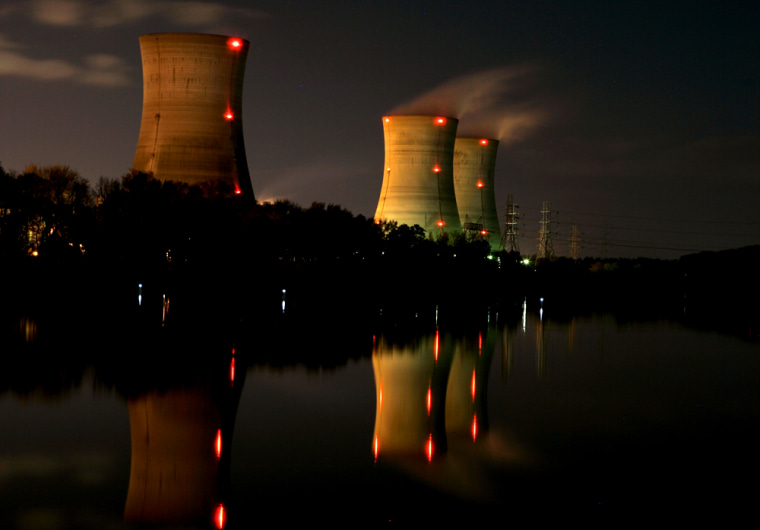The Nuclear Regulatory Commission said Monday that nuclear power plant operators should not be expected to make reactors crash-proof to an airliner attack by terrorists and that stopping any such attack is the military's responsibility.
In a revised security policy, the federal agency directed nuclear plant operators to focus instead on preventing radiation from escaping in case of such an attack and to improve evacuation plans to protect public health and safety.
“The active protection against airborne threats is addressed by other federal organizations, including the military,” the NRC said in a statement.
The agency rejected calls by some nuclear watchdog groups that the government establish firm no-fly zones near reactors or that plant operators build “lattice-like” barriers to protect reactors, or be required to have anti-aircraft weapons on site to shoot down an incoming plane.
The NRC, in a summary of the mostly secret security plan, said such proposals were examined, but that it was concluded the “active protection” against an airborne threat rests with organizations such as the military or the Federal Aviation Administration.
It said that various mitigation strategies required of plant operators — such as radiation protection measures and evacuation plans — “are sufficient to ensure adequate protection of the public health and safety” in case of an airborne attack.
The commission unanimously approved the plan, which has been the subject of internal discussions for 15 months, in a 5-0 vote at a brief meeting without discussion.
“This rule is an important piece, but only one piece of a broader effort to enhance nuclear power plant security,” NRC Chairman Dale Klein said in a statement.
The defense plan, formally known as the Design Basis Threat, spells out what type of attack force the government believes might target a commercial power reactor and what its operator must be capable of defending against.
Plan assumes small force
While details are sketchy because of security concerns, the plan requires defense against a relatively small force, perhaps no more than a half-dozen attackers, but that they could come from multiple directions including by water and could include suicide teams.
The plan, which formally approves many of the procedures that have long been in place, reflects the increased concerns raised by the Sept. 11, 2001, terrorist attacks. It also includes measures to address cyber attacks, according to the NRC.
Some members of Congress and nuclear watchdog groups have argued that the requirements fall short of what is needed, given what was learned by the Sept. 11 attacks on the twin towers in New York and at the Pentagon.
These critics have argued that defenders of a reactor should be ready to face up to 19 attackers — as was the case on Sept. 11 — and expect them to have rocket-propelled grenades, so-called “platter” explosive charges and .50-caliber armor-piercing ammunition.
The NRC does not assume such weapons being used and rejected the idea of a 19-member attack force, maintaining that the Sept. 11 attacks actually were four separate attacks, each by four or five terrorists.
Sen. Barbara Boxer, D-Calif., said that NRC appears not to have followed the direction of Congress “to ensure that our nuclear power plants are protected from air- or land-based terrorist threats” of the magnitude demonstrated on Sept. 11.
The NRC “has missed an opportunity to provide the public with a real solution to the nuclear reactor security problem,” said Rep. Edward Markey, D-Mass., a frequent critic of the nuclear industry and the NRC.
Daniel Hirsch, president of the Community to Bridge the Gap, a California-based nuclear watchdog group that had urged the NRC to require physical barriers to keep planes from hitting reactors, called the security measures “irresponsible to the extreme.”
“Rather than upgrading protections, (the NRC plan) merely codifies the status quo, reaffirming the existing, woefully inadequate security measures already in place at the nation’s reactors,” said Hirsch.
'Reasonable' requirements
NRC officials have emphasized that the defense plan should require what is “reasonable” to be expected of a civilian security force at the 103 commercial nuclear power reactors.
In an unclassified summary of the DBT, the NRC maintains that studies “confirm the low likelihood” that an aircraft crashing into a reactor will damage the reactor core and release radioactivity, affecting public health and safety.
“Even in the unlikely event of a radiological release due to a terrorist use of a large aircraft against a nuclear power plant, the studies indicate that there would be time to implement the required onsite mitigating actions,” says the summary.
Those “mitigation measures in place are sufficient to ensure adequate protection of the public health and safety,” it continued.
The nuclear power industry has argued that protection against an air attack — or one using a large ground attack force — should be the responsibility of the government.
Responding to the NRC’s action Monday, the Nuclear Energy Institute cited a $1 million study by the Electric Power Research Institute last year that concluded the concrete enclosure that surrounds a reactor will withstand the impact of a large jetliner without releasing radiation.
